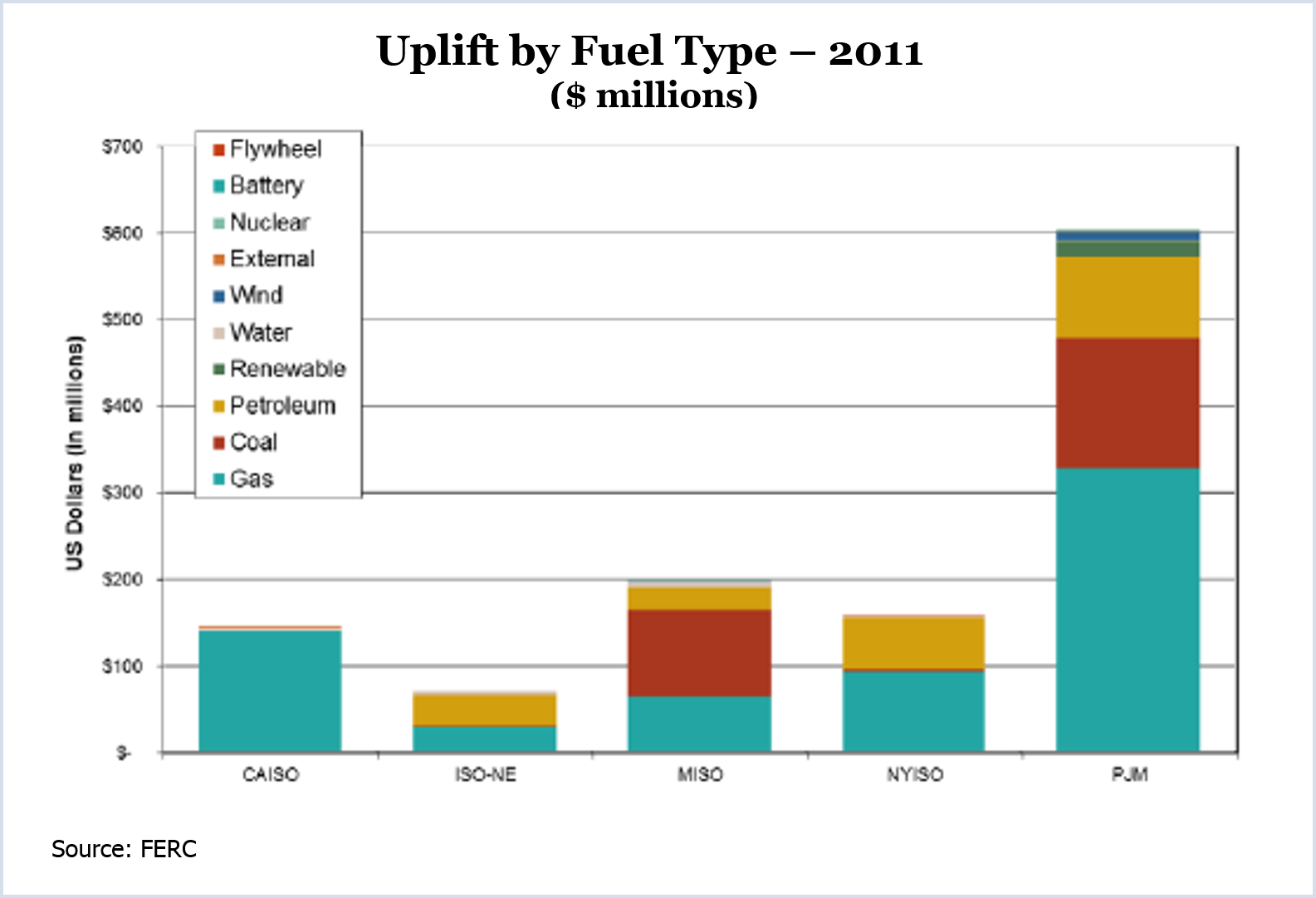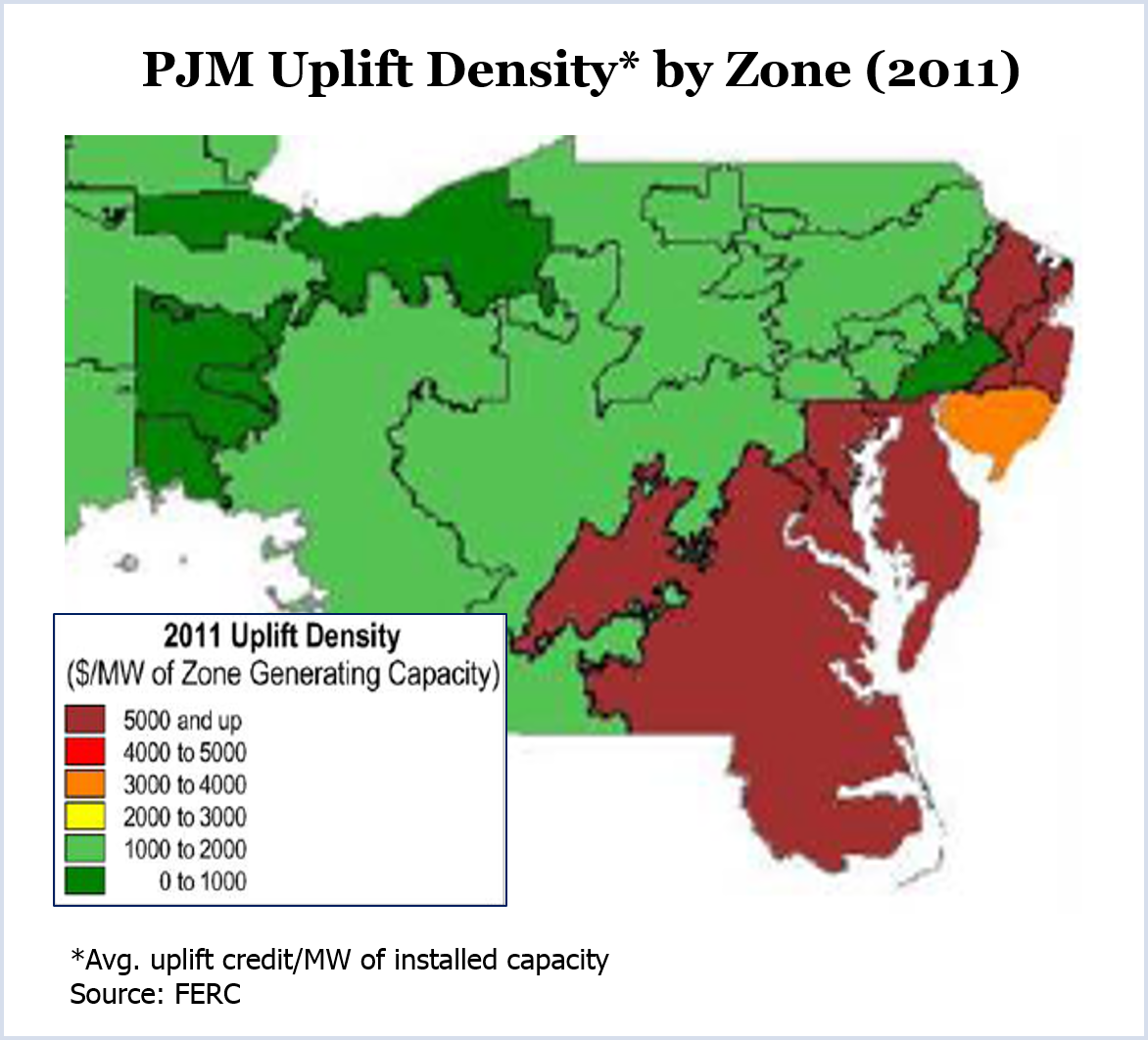
The FERC staff report found that PJM’s uplift ranked second among organized markets from 2009 to 2013, with charges increasing from about $0.50/MWh to more than $1/MWh over that period. Only NYISO was consistently higher.
The report also found that:
- Some resources and regions, such as PJM’s Dominion-Virginia and Delmarva zones, receive a disproportionate volume of uplift payments. PJM had among the highest concentrations of uplift payments, with 19 generating plants receiving more than $10 million and 33 receiving at least $5 million in 2013, the 33 representing 82% of total uplift for the year.
- Uplift payments are closely related to differences between coal and natural gas prices and divergences between day-ahead and real-time prices.
- The volatility of uplift costs varies across RTOs and ISOs. It has risen in three of the five markets studied, including PJM.
- A lack of transparency on the location of uplift credits and the reasons they are incurred are inhibiting market participants from making investments that could reduce the costs.
Sept. 8 Workshop
The report was intended to frame issues for discussion at FERC’s Sept. 8 workshop on uplift payments in energy and ancillary service markets (AD14-14).
FERC had said in June that it would convene a series of workshops to consider rule changes regarding uplift, price caps and other issues affecting price formation in PJM and other RTOs and ISOs.
The commission said its inquiry was prompted by comments made at recent technical conferences on capacity markets and the grid’s response to the recent severe winter. The workshops will consider ways to address limitations in RTO market software that prevent RTOs from modeling all system parameters, such as voltage constraints and generator operating constraints. (See FERC to Tackle RTO Uplift, Price Formation.)
Among those scheduled to speak at the conference are PJM Market Monitor Joe Bowring; Stu Bresler, PJM vice president of market operations; Jason Cox of Dynegy; Wesley Allen, representing the Financial Marketers Coalition; Judith Judson, representing the Energy Storage Association; Harry Singh of J. Aron & Co.; and Bob Weishaar of the PJM Industrial Customer Coalition.
Uplift Tab: $5.5 Billion

While the report noted the charges were a small fraction of energy costs, it said “a failure to make the causes transparent and to price them into the energy and ancillary services markets can undermine the effectiveness of price signals and efficient system utilization and mute investment signals. Volatile uplift charges may also create financial uncertainty for customers, depress liquidity and reduce market efficiency.”
PJM market participants have complained that uplift costs create unnecessary risk because they are unpredictable and not hedgeable.
The persistence of uplift in regions such as the Delmarva Peninsula “may indicate that market pricing is consistently failing to fully capture costs associated with committing and dispatching those resources or the existence of market work-arounds,” the report added. It noted that one PJM generating plant received at least $60 million in uplift annually in four of the five years studied.
The report said added transparency would aid development of solutions to reduce uplift. “For instance, knowing that the vast majority of uplift in a particular import-constrained zone is related to the provision of reactive power could make clear to market participants that the zone is reactive power deficient. This could lead to proposals to address reactive power compensation and potentially send a price signal to enhance reactive power capability. On the other hand, knowing that a majority of uplift in a particular zone is related to local ‘reliability’ could suggest that the model is not incorporating certain constraints or the operators are conservatively committing units to address generic concerns,” the report said.
PJM’s Market Monitor has called on PJM to identify the generators receiving uplift, but PJM officials said they are prevented from doing so by confidentiality rules and would require a FERC order giving them approval. The Monitor says the prohibition against disclosure of market-sensitive information should not apply to uplift. (See PJM Won’t Name Uplift Recipients.)


